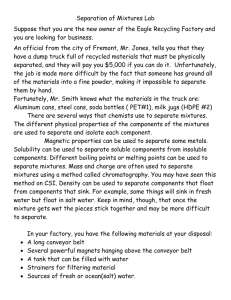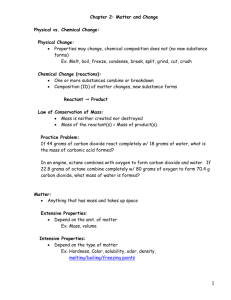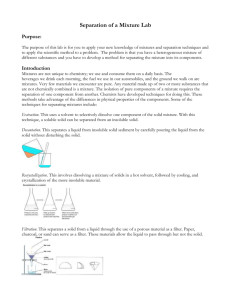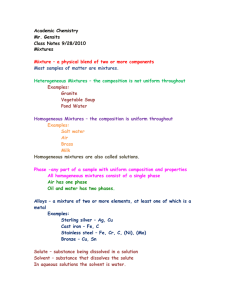Assessment Task - Curriculum Support
advertisement
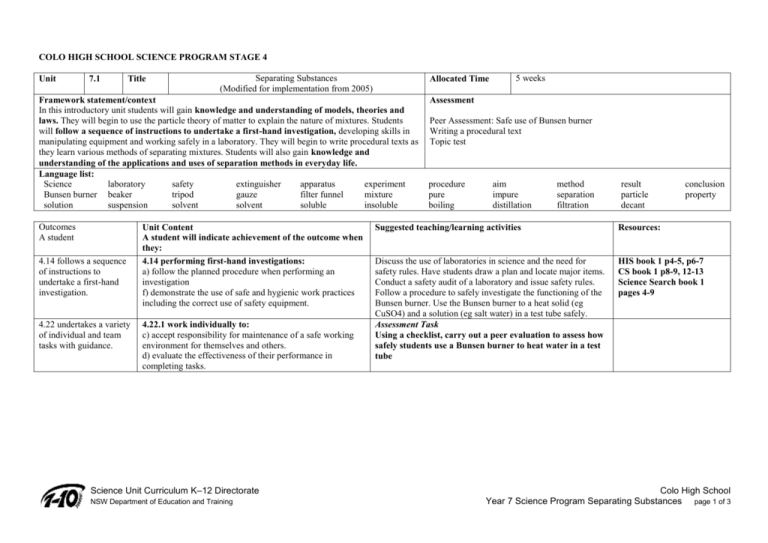
COLO HIGH SCHOOL SCIENCE PROGRAM STAGE 4 Unit 7.1 Title Separating Substances (Modified for implementation from 2005) Allocated Time Framework statement/context In this introductory unit students will gain knowledge and understanding of models, theories and laws. They will begin to use the particle theory of matter to explain the nature of mixtures. Students will follow a sequence of instructions to undertake a first-hand investigation, developing skills in manipulating equipment and working safely in a laboratory. They will begin to write procedural texts as they learn various methods of separating mixtures. Students will also gain knowledge and understanding of the applications and uses of separation methods in everyday life. Language list: Science laboratory safety extinguisher apparatus experiment Bunsen burner beaker tripod gauze filter funnel mixture solution suspension solvent solvent soluble insoluble Outcomes A student 4.14 follows a sequence of instructions to undertake a first-hand investigation. 4.22 undertakes a variety of individual and team tasks with guidance. Unit Content A student will indicate achievement of the outcome when they: 4.14 performing first-hand investigations: a) follow the planned procedure when performing an investigation f) demonstrate the use of safe and hygienic work practices including the correct use of safety equipment. 4.22.1 work individually to: c) accept responsibility for maintenance of a safe working environment for themselves and others. d) evaluate the effectiveness of their performance in completing tasks. Science Unit Curriculum K–12 Directorate NSW Department of Education and Training 5 weeks Assessment Peer Assessment: Safe use of Bunsen burner Writing a procedural text Topic test procedure pure boiling aim impure distillation method separation filtration result particle decant conclusion property Suggested teaching/learning activities Resources: Discuss the use of laboratories in science and the need for safety rules. Have students draw a plan and locate major items. Conduct a safety audit of a laboratory and issue safety rules. Follow a procedure to safely investigate the functioning of the Bunsen burner. Use the Bunsen burner to a heat solid (eg CuSO4) and a solution (eg salt water) in a test tube safely. Assessment Task Using a checklist, carry out a peer evaluation to assess how safely students use a Bunsen burner to heat water in a test tube HIS book 1 p4-5, p6-7 CS book 1 p8-9, 12-13 Science Search book 1 pages 4-9 Colo High School Year 7 Science Program Separating Substances page 1 of 3 Outcomes A student 4.7 describes observed properties of substances using scientific models and theories Unit Content A student will indicate achievement of the outcome when they: 4.7.5 mixtures: a) identify some common mixtures. b) identify, using examples, the importance of water as a solvent. c) describe aqueous mixtures in terms of solute, solvent and solution. 4.7.1 the particle model of matter: a) Identify that matter is made of particles that are continuously moving and interacting. 4.7.5d) identify situations where the processes of filtration, sedimentation, sieving, distillation, chromatography, evaporation, condensation, crystallization and magnetic attraction are appropriate to separate components of a mixture Suggested teaching/learning activities Working in a group, have students write down a definition of a mixture and generate a list of mixtures. Compare definitions. Discuss methods of classifying mixtures (e.g. homogeneous or heterogeneous). Examine a bottle of soft drink. Is it a pure substance or a mixture? Explain the concept of a solution and relate this to the soft drink naming the solvent and the various solutes. Investigate the solubility of a range of common substances. Compare solutions with suspensions. Draw simple diagrams to show particles in various mixtures such as solutions and suspensions. Familiarize students with basic equipment used to carry out a range of separation techniques. Discuss everyday applications of these separation techniques (View video: Separating Mixtures) Resources: HIS book 1 p45-49 CS book 1 p28-32 Science Now book 1 pages 87-93 Science Search book 1 pages 10-13, 30-33 CS book 1 p6-7, p3235 HIS book 1 p50-55, p58-61 Video: Separating Mixtures 4.14 follows a sequence of instructions to undertake a first-hand investigation 4.14 perform first-hand investigations: a) follow the planned procedure when performing an investigation b) use time and resources effectively c) safely and efficiently construct, assemble and manipulate identified equipment hygienic work practices including the correct use of safety equipment Science Unit Curriculum K–12 Directorate NSW Department of Education and Training Filter muddy water to collect residue and filtrate. Evaporate the water from soft drink to collect solutes. Decant a mixture of oil and water using a separating funnel Use magnetic separation to extract iron from sand. Sieve and mixture of sediments and pebbles. Science Search book 1 pages 140-147 Science Now book 1 pages 94-99 Colo High School Year 7 Science Program Separating Substances page 2 of 3 Outcomes A student 4.18 with guidance, presents information to an audience to achieve a particular purpose. Unit Content A student will indicate achievement of the outcome when they: 4.18 present information: a) select, and use appropriately, a discussion, explanation, procedure, exposition, recount, report, response or experimental record for oral or written presentation e) use drawings and diagrams to present information clearly. Suggested teaching/learning activities Resources: Discuss the purpose and features of a procedural text. Teacher models the process of writing a procedural text for carrying out a demonstrated separation, e.g. distillation, centrifuging and chromatography. Show students how to draw scientific diagrams of equipment set up for separations. Assessment Task Teacher performs a separation (eg. separate tea leaves from sugar and water using filtration and evaporation) students observe making rough notes then use these to write a procedure. Extension Activity 4.3 identifies areas of everyday life that have been affected by scientific developments 4.3 a) Identify and describe examples of scientific concepts and principles that have been used in technological developments (including Australian examples) Science Unit Curriculum K–12 Directorate NSW Department of Education and Training Present students with a mixture of sand, salt, polystyrofoam balls and iron fillings. Have them work in a group to plan a series of separations to recover each component of the mixture. They should write a procedure for each separation and carry it out Work in a group to investigate an application of separation technology to everyday life. Gather information and carry out a separation simulation into one of the following processes; Sewage treatment Water purification Separation of mineral from waste rock using froth floatation - an Australian innovation Present information to the class in the form of a poster and/or a demonstration. Assessment task Topic test HIS book 1 p56-57 CS book p36-41 Science Now book 1 pages 102-103 Science Search book 1 pages 148-151 Colo High School Year 7 Science Program Separating Substances page 3 of 3




